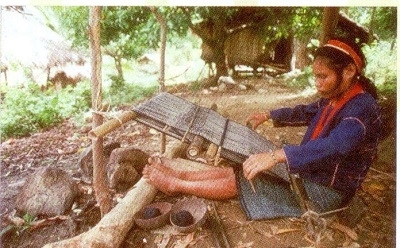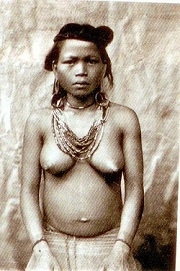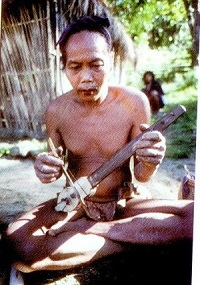Three Lessons in Table Manners
Photographs courtesy of Dario Novellino
How to teach an anthropologist to eat
I suppose it was my father's fault. He was the one who used to browse through all of the secondhand bookstores in Boston and bring home stacks of old National Geographic magazines. And I, then no more than six years old, was the one who would find them piled up on a table in the living room and become enthralled with the pictures of Masai warriors spearing lions in Kenya; pygmies of the Congo's Ituri Forest posing with their bows and arrows; Indians of the Amazon proudly displaying their collection of shrunken heads; and New Guinea tribesmen festooned with pig grease, war paint, and bird-of-paradise feathers. For an impressionable little kid growing up in a somewhat down-at-heels, working class Jewish neighborhood in one of Boston's old streetcar suburbs, those pictures were irresistible, and they all but ensured that I was destined to declare anthropology as my major on my very first day in college.
It was thus that I found myself deep in the dark, howling jungles of Borneo in Indonesia several years later, at the start of fieldwork for a Ph.D. degree, searching for members of an elusive, seldom-seen tribe of forest people known as the Punan. I, the ultimate urbanite - who had never so much as gone camping before or even slept outdoors - was now flitting through the rain forest with two native guides, under a thick tree canopy that barely let in sunlight, searching for a mysterious, hidden tribe that up to that point had been quite content to remain mysterious and hidden.
After several days of stumbling through the jungle, being rained on, devoured by insects and attacked by a malevolent host of bloodsucking leeches, we suddenly made contact. Out of the green darkness a few feet away stepped a man almost totally naked except for a loincloth, a bead necklace, and what appeared to be some sort of animal's tooth in his upper left ear. He held a blowgun; a rattan belt around his waist held a bamboo container with poison darts. Moments later, another figure materialized, a woman - also naked save for a bead necklace, bracelets, and anklets, evidently the man's wife.
The man pursed his lips and produced a long, low trilling whistle, which caused two more people to emerge from the trees - both of them small boys under the age of ten. And thus we stood, in a tiny clearing in the midst of the jungle, the little family gaping in wonder at the first white man they had ever seen, and I gaping in wonder at the first Punan that I had ever seen. All of them, including the woman, were lithe and well-muscled. Their hair was matted and dirty, their faces were streaked with grime, and their unwashed bodies were criss-crossed with a thousand cuts, scratches and scars acquired from life in a merciless, unforgiving environment. After a moment or two more of our mutual gaping, and a terse exchange of words with my guides, the little family of the forest invited me home for lunch.
They led us through the woods for some 20 minutes, until we came to a small bamboo lean-to, roofed over with a rank and mouldy, bug-infested thatch. This was the family's home. I eased myself into their dwelling, praying that I wouldn't fall through the fragile bamboo and rattan floor.
The man, my host, rummaged around behind the house and produced a large earthenware Chinese jar, with a dragon figure in base relief near the rim - one of thousands of such jars scattered across Southeast Asia, relics of long ago trade with Ming Dynasty China. He removed some sort of makeshift cover, plunged his arm into the jar, and extracted a huge, dripping handful of something that looked like...well... let's just say it and get it over with - like phlegm. He let this loose, slimy substance ooze off his hand and onto a large leaf. Two more plunges into the jar, two more dripping handfuls of this awful looking stuff, and then the leaf with its quivering light-grey slop was ceremoniously placed before me, with hearty invitations to dine. While everyone else was being served, and I was busily engaged in waving a multitude of flies away from what was apparently to be my lunch, my guides explained that we were about to partake of rendered pig fat, melted months, and perhaps years, ago off the flesh of the wild boars these people hunted for food. I glanced again at the animal tooth in my host's ear as my guides explained that the fat - along with a few pieces of flesh and gristle - was usually set aside and stored away, for just such high social occasions as this.
I was young. I was adventurous. And I certainly was not then wearing the black leather kippa that now adorns my graying, middle-aged head. I said to myself, "Well, when in Rome....." and began to eat the rancid pig fat. Tentatively at first, I sampled one or two tastes of the stuff with the tip of one forefinger. Then, determined to show my hosts how much I appreciated their kind hospitality - or perhaps just wanting to be finished with this as quickly as possible - I began to shovel the pig fat into my mouth with almost deranged abandon, one loose slimy handful after another. Before I knew it, pig fat was everywhere - all over my face, in my beard, on my shirt, in my lap, and all across the floor. After a while, I became aware that my jungle hosts and trusty guides were all staring at me with what could only be described as arch disapproval. I asked what was wrong, to which my guide replied with a withering sneer," "You're kind of messy, aren't you?" I then realized, with growing embarrassment, that despite their remoteness and apparent deshabille, these "primitive" people of the rain forest had table manners and notions of dining etiquette as strict a anyone else's, and that I had oafishly flouted them.
My next display of gaucherie occurred some months later on the Indonesian Island of Java, where I was resting, recreating and recovering from several grueling months on the Island of Borneo. I had been holed up and chilling out in a quiet student dormitory in the ancient city of Jogjakarta, when one of my housemates - a young Javanese medical student - decided to go home to his village for a visit with his family and invited me to come along. After a 5 hour ride across Java on a train so crowded I was able to sleep comfortably standing up. Followed by another bone wracking hour over bumpy, unpaved roads in a rickety horse drawn cart, we reached my friend's village, a small cluster of houses and gardens set amidst verdant rice paddies and groves of coconut palms. Immediately upon our arrival, the sleepy little village sprang into action and feted us with a resplendent welcome home dinner, consisting of huge mounds of boiled white rice, surrounded by numerous small side dishes of meat and vegetables - cooked sweet and spicy in the style of central Java and served without silverware, to be eaten by hand.
Maybe I was exhausted from the long, tiring journey. Perhaps I was excited to be in a real Javanese village, suffused with its rich, unspoiled, authentic Javanese culture. Then again, I might simply have been distracted by all of the exquisitely beautiful Javanese girls who were part of the crowd that had gathered around to welcome us. Or maybe I was just very hungry. There had to have been a reason - a good, compelling reason - for me to have then committed one of the most idiotic social faux pas of my life. With complete disregard for everything I had read, heard, and been taught in graduate school about this part of the world, I sat down to dinner with my friend and his family, smiled pleasantly, thanked my hosts profusely for their gracious hospitality, and began to eat with my left hand. That's right, I am left-handed, and into the nearest mound of steaming, pure white rice - as well as into each and every succulent little side dish - went my eager, grasping left hand. How could I have forgotten that virtually everywhere in South and Southeast Asia the right hand is considered "clean" while the left hand is scorned as "dirty"; and that the right hand is used for touching people, giving and receiving things, writing, cooking and eating - while the left hand is ingloriously reserved for cleaning oneself after going to the toilet? Even now, more than a quarter of a century later, I can still see the looks of utter shock and disbelief on the faces of my bewildered hosts.
My third lesson in table manners came four years later in the Philippines, on the island of Mindoro, high up in the mountains with a very remote hill tribe known as the Hanuno'o. Still very traditional, these people lived in small, almost hidden villages in the island's mountainous interior, building sturdy little houses of bamboo, weaving their own cotton and dying it blue with their own native indigo, composing songs and poetry and making music on traditional home-made string instruments, writing poetry and messages to each other on bamboo in their own ancient native script, filing their teeth and chewing betel nut, and living much like their ancestors did centuries ago. It was my privilege to dwell among these people and share their wonderful lives for a little more than three years.
The life of this tribe revolved around the annual planting and harvesting of their own native strains of upland rice, which they sowed on the steep, misty hillsides of their tribal territory, and which was then nurtured by tropical sunshine and fed by monsoon rains. The Hanuno'o were a rather laid back tribe - gentle, peaceful and easy-going to a fault, except about anything concerning their rice. I was told, "Our rice is sacred. It has come down to us from our forefathers. As long as we respect and cherish it, it will come to us in abundance every year."
The respect the Hanuno'o had for their native rice was expressed in the rituals that accompanied planting it, the festivities that went along with harvesting it, and the reverence they felt when eating it. Unlike the Javanese, the Hahuno'o didn't care a feather or a fig which hand one used to eat their rice, but they were very strict about the direction in which the rice on one's plate moved. Barely a week went by after my arrival to the tribe before a very pretty, charming, vivacious, sexy and unfortunately married young Hanuno'o woman named Oo-ming was assigned by the village elders to teach me how to eat. "You must never give the rice the impression you don't respect it," she solemnly told me in her soft, sweet voice. "You must never let so much as a single grain fall from the edge of your plate. Never make a motion that might be interpreted as pushing rice away from you. Always, always pull the rice toward you. Start taking your handfuls of rice from the outer edges of your plate, and constantly pull the rest of the rice toward you, toward you, always towards you, until you have finished the very last handful."
It has been more than 25 years since anyone has offered me pig fat, but I must admit that I am still somewhat messy. And when I left Java I gradually reverted to eating with my left hand. Fortunately, no one here in Israel seems to mind. But for some reason the etiquette I acquired among the Hanuno'o has stayed with me throughout the years. I continue to eat rice - all rice, even Uncle Ben's - exactly as I was taught to do by a beautiful girl named. Oo-ming.










Comments